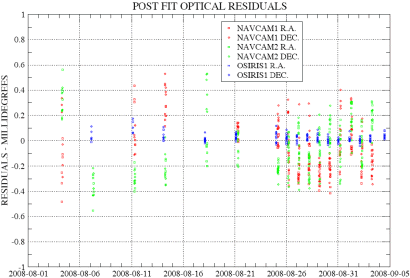Optical navigation post-fit residuals

Date: 04 September 2008
Satellite: Rosetta
Depicts: Plot of post-fit residuals from optical navigation campaign
Copyright: ESA
In an ESA first, images of asteroid Steins obtained with Rosetta's on-board cameras were used in an optical navigation campaign to help place the spacecraft into its optimum trajectory for a fly-by of the asteroid on 5 September 2008.
The images were obtained by the two navigation cameras (NAVCAM A and B) and the OSIRIS instrument at seventeen navigation slots over a period of one month leading up to the fly-by date. The navigation slots were on 4, 7, 11, 14, 18, 21, 25, 26, 27, 28, 29, 30 and 31 August and on 1, 2, 3 and 4 September 2008.
This plot shows the post fit residuals (for both right ascension and declination) for all images obtained by the two NAVCAMs (red and green) and OSIRIS (blue) on the seventeen navigation slot dates (excluding the NAVCAM images from 4 September).
Detailed statistics for this data set is given below, listing: the total number of images obtained on the seventeen dates, the mean residual of the data to the last solution, and both the root mean square and standard deviation of the residuals (all in millidegrees).
| Optical Navigation post fit statistics (residuals in millidegrees relative to solution) | ||||
|
Right Ascension | ||||
| camera |
No. |
mean | root mean sq. | standard dev. |
| NAVCAM A |
121 |
-0.108 |
0.203 |
0.172 |
| NAVCAM B |
128 |
-0.036 |
0.194 |
0.191 |
| OSIRIS |
75 |
0.013 |
0.035 |
0.032 |
| ALL |
324 |
-0.052 |
0.175 |
0.167 |
|
Declination | ||||
| NAVCAM A |
121 |
-0.001 |
0.219 |
0.219 |
| NAVCAM B |
128 |
-0.067 |
0.241 |
0.232 |
| OSIRIS |
75 |
0.033 |
0.048 |
0.034 |
| ALL |
324 |
-0.019 |
0.204 |
0.203 |

